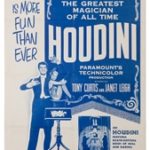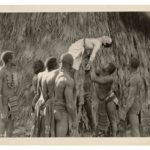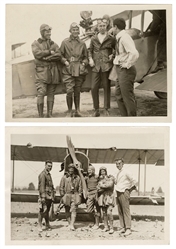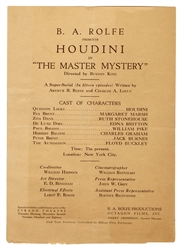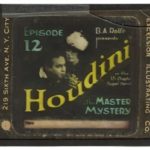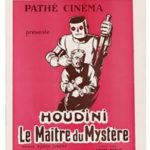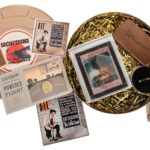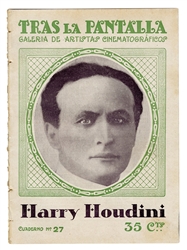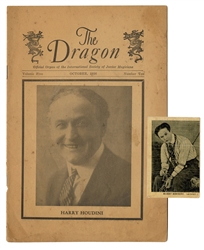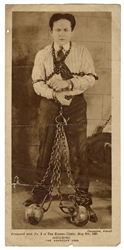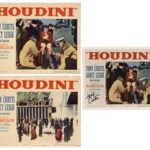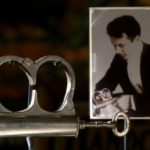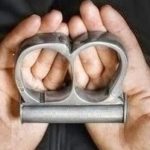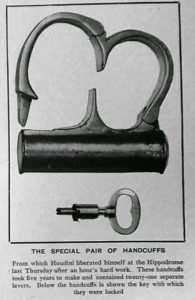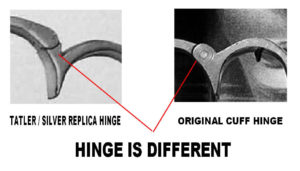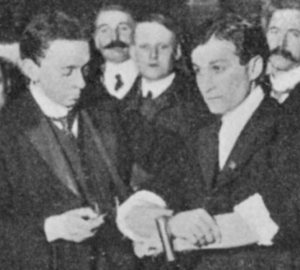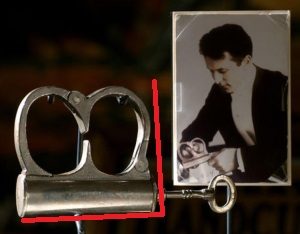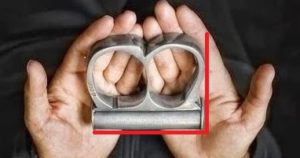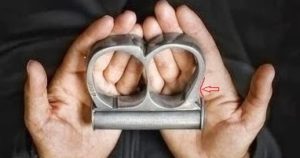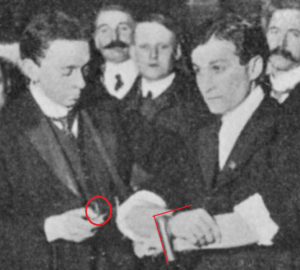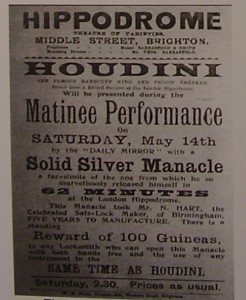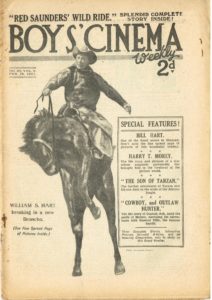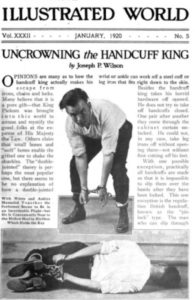
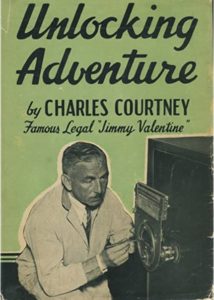
Added a couple of new items to my collection while researching the Mirror Cuff:
- “Uncrowning the Handcuff King” by Joseph P. Wilson, January 1920 issue of Illustrated World Magazine
- “Unlocking Adventure” by Charles Courtney (1942)
Both are discussed in Chapter Eight, “The Mirror Handcuff Mystery”, of Patrick Culliton’s book, “the Key” and offer key insights into the Mirror Cuff Challenge.
- Joseph P. Wilson’s theory on how Houdini Escaped the Mirror Cuff
- Locksmith, Charles Courtney had come upon a Mirror Cuff inside Houdini’s private safe after the magician’s death and offered to open them, but Bessie inferred that only Houdini was allowed to unlock them
Culliton asks the question, “Could it be that Bessie Houdini was preventing Courtney from discovering that beyond that single Brahma lock lay the “false works” that Wilson described in his article?”
Joseph P. Wilson’s theory on how Houdini escaped the Mirror Cuff, is also discussed in the chapter, “How He Did It (Theory Two)” of Joe Posnanski’s book, “The Life and Afterlife of Harry Houdini”. Posnanski’s says “Wilson did not get it right”, since his claim was built around the premise that the Mirror Cuffs were gaffed and the one’s in David Copperfield’s collection are not. Well the Tatler Cuff may have been gaffed.
Here is the related snippet from Courtney:
Mrs. Houdini…asking me to unlock her husband’s safe, the one he used in his act. In the safe, he had told her, was something to treasure but no one had been able to open the lock. On my next trip [1935] to the West, I paid her a visit in Hollywood. This gentle, tiny woman was living in a small home [2435 Laurel Canyon Blvd] surrounded by her keepsakes and sharing her home with a half-dozen elderly actresses who had no work. Her two chief concerns were a small two- or three pound monkey [named Satan], a pet that she carried everywhere perched on her shoulder, and portrait of Houdini under which an oil lamp burned perpetually. The lock on the chest was a trick one, I knew, so I asked Mrs. Houdini very carefully just how her husband opened it.
“Houdini never touched it,” she told me. “He just passed his hands over it and it opened.” I went around the corner to the hardware store, returned in a few minutes and passed my hands over the lock. It opened immediately. The elderly actresses crowded around and asked me how I learned the trick, but my only magic was a small magnet that clicked with another in the shackle of the lock. On the floor of the chest lay the beautiful silver [?] handcuffs that the city of London had once presented to the magician. They were fastened with one of the finest Bramah locks that I have seen. It would have been interesting to open them, but Mrs. Houdini shook her head.
“I must never let anyone touch the lock. You may have the safe for your collection; Houdini would have wished it. But these handcuffs–he promised that if he can pierce the veil of death, he will unlock them. Then I shall know that he has returned to me.”
The Billboard August 3, 1935 mentions the following:
THE LATE HOUDINI’S trick of opening a closed safe by passing his hands over it was exposed last week by Charles Courtney, president of the Master Locksmiths Association of America. Mrs. Houdini had sent her late husbands private safe to Courtney’s shop at 530 West 125th street, New York. There were some papers she needed and Courtney managed to open the safe in the usual way, turning the dial. Later he tried to open it as Houdini did and discovered that a magnet passed over the surface caught a hidden tripper and connected with the dial.
The Billboard September 7, 1935 tells the story this way:
CHARLES COURTNEY, master locksmith, is in San Diego, Calif, on his way from New York to Honolulu where he hopes to open the vaults of a submerged treasure ship. Before leaving New York on his present venture, Mrs. Harry Houdini telegraphed him from Hollywood asking that he open a safe in New York which formerly belonged to her husband. Houdini had closed the safe for the last time and the secret of the combination was lost after his death. He and Courtney had been great friends. Courtney opened the safe and presented the contents to Mrs. Houdini. Besides documents, the significance of which Courtney refused to reveal, he found a pair of silver [?] handcuffs presented to Houdini by the city of London.
So a Mirror Cuff [?] was hidden in a safe for a number of years until Courtney opened the safe in the mid-1930’s [1935].
Bonus:
According to the February 1934 Linking Ring article, “With the Old Masters” by William W Durbin, President I.B.M., Kenton Ohio:
Today, I have in my possession, presented to me by Mrs. Houdini, the handcuffs which were made by Birmingham blacksmith and who took five years in making same, which Houdini got out of in the London Hippodrome after he worked for almost seventy minutes to release himself…I have never been able to find any magician or other person who can open and close these handcuffs.
I echo Chris Gower’s theory on Handcuffs.org:
So perhaps, Durbin was given the original Mirror Cuff [aka Tatler Cuff].
Chris also mentions:
I do not believe the two cuffs that are now in David Copperfield’s collection [DC Cuff and Solid Silver Replica] have ever been split up especially as we know both were offered to The Daily Mirror in the early 1970’s and were subsequently sold or auctioned together when I think Radner/Muller bought them.
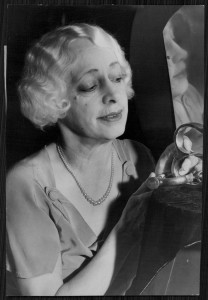
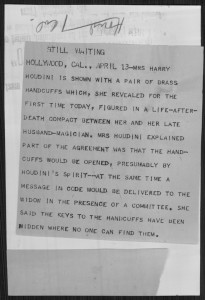
The David Copperfield Mirror Cuff (aka DC Cuff) interlocked with another pair of cuffs made its first public reappearance [the day Thurston died] in an April 13, 1936 newspaper, where it was mentioned that the keys to the handcuffs have been hidden where no one can find them.
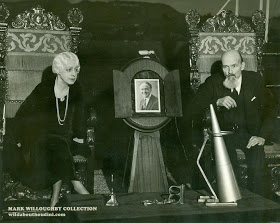
The DC Cuff interlocked with another pair of cuffs was also on the table at the October 31, 1936 séance.
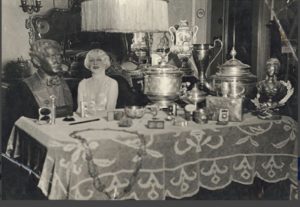
The long key (for the DC Cuff) made its first appearance in the photo [most likely taken in the late 1930s] of Bess with all of her keepsakes on the table. This also shows the Solid Silver Replica and DC Cuff together for the first time.
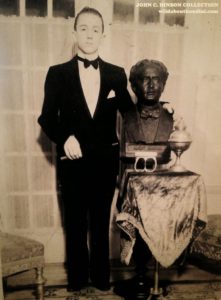
The Solid Silver Replica (without the DC Cuff), can be seen for the first time in the photo [1938] of Vincent Hinson, younger brother of Harry Houdini Hinson.
The London Express, March 18, 1904 reported:
and after two and half minutes “click, click, click” was heard. The committee thought that Houdini had freed himself, but it was only the beginning of the end, for the Handcuff King had only broken free from the first lock. There were twenty others to conquer before he could get his hands free.
So, I personally believe, Houdini engineered the entire challenge, was first out of the Tatler Cuffs in two and half minutes, and the rest was showmanship. After the challenge, the Tatler Cuff vanishes [later given to Durbin] and the unbeatable David Copperfield Cuff appears [later found in a safe].
Where is the original Mirror Cuff given to Durbin?
W.W. Durbin died on Feb 4, 1937 at the age of 70. According to Magicpedia:
William W. Durbin (1866-1937) was a politician, magician and owner of the the American Egyptian Hall Theater and Museum from Ohio. He was elected the first elected president of the International Brotherhood of Magicians and was editor for their Linking Ring magazine (1927 until 1937)…He claims he was offered by Kellar to be his successor before it was given to Thurston…Durbin created a tiny Egyptian Hall theater in his home, launched the first magic convention and was an avid, if careless, collector of magic memorabilia. His collection (which he started in 1895) became the nucleus of the Egyptian Hall Museum collection, later [moved to Nashville Tennessee and] stewarded by magic historian David Price, in 1953. After David’s death, his son, Dave Price III, a circus enthusiast and former magician took over the museum and eventually sold the contents to Mike Caveney and George Daily. Caveney retained the rights to the Egyptian Hall Museum name.
I did a quick search on Handcuffs.org for other references to Durbin and found the following April 29, 2009 thread started by John Bushey:
The third installment of the Jay Marshall estate is being held today. They have a pair of Hamburg 8’s with rectangular keyhole and are advertising them as Houdini’s. Jay included a note on where he obtained them (Bennett) and was told they were Houdini’s. After checking with a few friends they can be dated to Houdini’s lifetime via a 1923 photo, but not with Houdini in them but another escape artist [Kolar].
The thread included a Kolar/Durbin photo (from Kevin Connolly’s collection) which showed Kolar in numerous handcuffs with the following annotation: With Best Wishes to W.W. Durbin From the Great Kolar 1/5/24
What does all this mean? Not sure, but there still could be hope Houdini’s Tatler Cuff still exists (possibly in the States).
Related:


